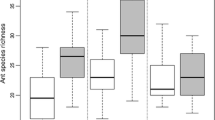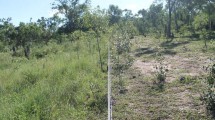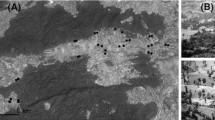Abstract
Agricultural development has contributed to the global erosion of biodiversity. The farmed matrix in agricultural landscapes can and must be important for the conservation of biodiversity and provision of ecosystem services, but this assumes that the matrix has biodiversity value. We investigate the contribution of pastures and crops to ant diversity on mixed farms in eastern Australia. Remnant native woodlands, pastures of native grasses, sown pastures of exotic species, and crops were sampled for epigaeic ants on 3 farms using pitfall trapping. Ants were sorted to species and assigned to functional groups. Ant species richness and functionality followed consistent patterns across the three farms. Significant differences in assemblage composition were found between the major habitat types, and in species richness between woodland and non-woodland habitats (native and sown pastures, and crops), which did not contribute appreciably to farm-level biodiversity: 1–10% of species were found only in the farmed matrix. Insect conservation in agricultural landscapes is important for the provision of ecosystem services, including pest control and the maintenance of soil condition. As the farmed matrix makes only a modest contribution to farm-scale biodiversity, appropriate management of the unfarmed parts of the landscape is critical and habitat restoration may be warranted where the level of native vegetation is low. Maintaining a mix of land uses within the production matrix will also be a necessary bet-hedging strategy in a world with changing climates, commodities, community expectations and farming practices.








Similar content being viewed by others
References
Andersen AN (1995) A classification of Australian ant communities, based on functional groups which parallel plant life-forms in relation to stress and disturbance. J Biogeogr 22:15–29
Andersen AN (1997) Functional groups and patterns of organization in North American ant communities: a comparison with Australia. J Biogeogr 24:433–460
Andersen AN, Hoffman BD, Muller WJ, Griffiths AD (2002) Using ants as bioindicators in land management: simplifying assessment of ant community responses. J Appl Ecol 39:8–17
Anderson MJ, Gorley RN, Clarke KR (2008) PERMANOVA + for PRIMER: guide to software and statistical methods. PRIMER-E, Plymouth, UK
Andrew N, Rodgerson L, York A (2000) Frequent fuel-reduction burning: the role of logs and associated leaf litter in the conservation of ant biodiversity. Austral Ecol 25:99–107
Armbrecht I, Perfecto I (2003) Litter-twig dwelling ant species richness and predation potential within a forest fragment and neighboring coffee plantations of contrasting habitat quality in Mexico. Agric Ecosyst Environ 97:107–115
Attwood SJ, Maron M, House APN, Zammit C (2008) Do arthropod assemblages display globally consistent responses to intensified agricultural land use and management? Glob Ecol Biogeog 17:585–599
Balmford A, Green RE, Scharlemann JPW (2005) Sparing land for nature: exploring the potential impact of changes in agricultural yield on the area needed for crop production. Glob Change Biol 11:1594–1605
Barrett GW, Freudenberger D, Drew A, Stol J, Nicholls AO, Cawsey EM (2008) Colonisation of native tree and shrub plantings by woodland birds in an agricultural landscape. Wildl Res 35:19–32
Bengtsson J, Angelstam P, Elmqvist T, Emanuelsson U, Folke C, Ihse M, Moberg F, Nystrom M (2003) Reserves, resilience and dynamic landscapes. Ambio 32:389–396
Benton TG, Vickery JA, Wilson JD (2003) Farmland biodiversity: is habitat heterogeneity the key? TREE 18:182–188
Bianchi FJJA, Booij CJH, Tscharntke T (2006) Sustainable pest regulation in agricultural landscapes: a review on landscape composition, biodiversity and natural pest control. Proc Roy Soc B 273:1715–1727
Bihn JH, Gebauer G, Brandl R (2010) Loss of functional diversity of ant assemblages in secondary tropical forests. Ecology 91:782–792
Bowen ME, McAlpine CA, House APN, Smith GC (2007) Regrowth forests on abandoned agricultural land: a review of their habitat values for recovering forest fauna. Biol Conserv 140:273–296
Bridle K, Fitzgerald M, Green D, Smith J, McQuillan P, Lefroy T (2009) Relationships between site characteristics, farming system and biodiversity on Australian mixed farms. Anim Prod Sci 49:869–882
Brown WL (2000) Diversity of ants. In: Agosti D, Majer JD, Alonso LE, Shultz TR (eds) Ants: standard methods for measuring and monitoring biodiversity. Smithsonian Institute Press, Washington, pp 45–79
Bullock JM, Pywell RF, Burke MJW, Walker KJ (2001) Restoration of biodiversity enhances agricultural production. Ecol Lett 4:185–189
Burel F, Baudry J, Butet A, Clergeau P, Delettre Y, Le Coeur D, Dubs F, Morvan N, Paillat G, Petit S, Thenail C, Brunel E, Lefeuvre JC (1998) Comparative biodiversity along a gradient of agricultural landscapes. Act Oecol-Int J Ecol 19:47–60
Chazdon RL, Colwell RK, Denslow JS, Guariguata MR (1998) Statistical methods for estimating species richness of woody regeneration in primary and secondary rain forests of NE Costa Rica. In: Dallmeier F, Comiskey JA (eds) Forest biodiversity research, monitoring and modelling: conceptual background and old world case studies. Parthenon Publishing, Paris, pp 285–309
Clarke KR, Gorley RN (2006) PRIMER v6: user manual/tutorial. PRIMER-E Ltd, Plymouth
Clough Y, Dwi Putra D, Pitopang R, Tscharntke T (2009) Local and landscape factors determine functional bird diversity in Indonesian cacao agroforestry. Biol Conserv 142:1032–1041
Colwell RK (2009) Estimates: statistical estimation of species richness and shared species from samples. Version 8.2. User’s guide and application. http://purl.oclc.org/estimates
Cramer VA, Hobbs RJ, Standish RJ (2008) What’s new about old fields? Land abandonment and ecosystem assembly. TREE 23:104–112
Crist TO (2009) Biodiversity, species interactions, and functional roles of ants (Hymenoptera: Formicidae) in fragmented landscapes: a review. Mymecolog News 12:3–13
Cunningham RB, Lindenmayer DB, Crane M, Michael D, MacGregor C (2007) Reptile and arboreal marsupial response to replanted vegetation in agricultural landscapes. Ecol Appl 17:609–619
Dauber J, Hirsch M, Simmering D, Waldhardt R, Otte A, Wolters V (2003) Landscape structure as an indicator of biodiversity: matrix effects on species richness. Agric Ecosyst Environ 98:321–329
Dauber J, Bengtsson J, Lenoir L (2006) Evaluating effects of habitat loss and land-use continuity on ant species richness in seminatural grassland remnants. Conserv Biol 20:1150–1160
Debuse VJ, King J, House APN (2007) Effect of fragmentation, habitat loss and within-patch habitat characteristics on ant assemblages in semi-arid woodlands of eastern Australia. Landsc Ecol 22:731–745
Dorrough J, Moll J, Crosthwaite J (2007) Can intensification of temperate Australian livestock production systems save land for native biodiversity? Agric Ecosyst Environ 121:222–232
Dufrêne M, Legendre P (1997) Species assemblages and indicator species: the need for a flexible asymmetrical approach. Ecol Monogr 67:345–366
Elmqvist T, Folke C, Nystrom M, Peterson G, Bengtsson J, Walker B, Norberg J (2003) Response, diversity, ecosystem change, and resilience. Front Ecol Environ 1:488–494
Fischer J, Fazey I, Briese R, Lindenmayer DB (2005) Making the matrix matter: challenges in Australian grazing landscapes. Biodivers Conserv 14:561–578
Fischer J, Lindenmayer DB, Manning AD (2006) Biodiversity, ecosystem function, and resilience: ten guiding principles for commodity production landscapes. Front Ecol Environ 4:80–86
Goldsbrough CL, Hochuli DF, Shine R (2003) Invertebrate biodiversity under hot rocks: habitat use by the fauna of sandstone outcrops in the Sydney region. Biol Conserv 109:85–93
Gomez C, Casellas D, Oliveras J, Bas JM (2003) Structure of ground-foraging ant assemblages in relation to land-use change in the northwestern Mediterranean region. Biodivers Conserv 12:2135–2146
Greenslade PJM (1973) Sampling ants with pitfall traps: digging in effects. Insectes Soc 20:343–353
Greenslade PJM (1974) Distribution of two forms of the meat ant, Iridomyrmex purpureus (Hymenoptera: Formicidae), in parts of South Australia. Aust J Zool 22:489–504
Greenslade PJM (1978) Ants. The physiological and biological features of Kunoth Paddock in Central Australia. CSIRO division of land resources management technical paper no. 4, Canberra
Greenslade PJM (1982) Diversity and food specificity of seed-harvesting ants in relation to habitat and community structure. Paper presented at the 3rd Australiasian conference on grasslands invertebrate ecology, Adelaide, 30 Nov–4 Dec 1981
Hoffmann BD, Andersen AN (2003) Responses of ants to disturbance in Australia, with particular reference to functional groups. Austral Ecol 28:444–464
Hole DG, Perkins AJ, Wilson JD, Alexander IH, Grice F, Evans AD (2005) Does organic farming benefit biodiversity? Biol Conserv 122:113–130
House APN, Burwell C, Brown SD (2006) Ant assemblages in brigalow regrowth vegetation. Ecol Manag Rest 7:136–140
House APN, MacLeod ND, Cullen B, Whitbread AM, Brown SD, McIvor JG (2008) Integrating production and natural resource management on mixed farms in eastern Australia: the cost of conservation in agricultural landscapes. Agric Ecosyst Environ 127:153–165
Lee S-M, Chao A (1994) Estimating population size via sample coverage for closed capture-recapture models. Biometrics 50:88–97
Lindsay EA, Cunningham SA (2009) Livestock grazing exclusion and microhabitat variation affect invertebrates and litter decomposition rates in woodland remnants. For Ecol Manag 258:178–187
Liu Y, Axmacher JC, Wang Ci, Li L, Yu Z (2010) Ground beetles (Coleoptera: Carabidae) in the intensively cultivated agricultural landscape of northern China—implications for biodiversity conservation. Insect Conserv Divers 3:34–43
Lobry de Bruyn LA (1993) Ant composition and activity in naturally-vegetated and farmland environments on contrasting soils at Kellerberrin, Western Australia. Soil Biol Biochem 25:1043–1056
Mac Nally R, Horrocks G (2002) Habitat change and restoration: responses of a forest-floor mammal species to manipulations of fallen timber in floodplain forests. Anim Biodivers Conserv 25:1–12
Matson PA, Vitousek PM (2006) Agricultural intensification: will land spared from farming be land spared for nature? Conserv Biol 20:709–710
Matson PA, Parton WJ, Power AG, Swift MJ (1997) Agricultural intensification and ecosystem properties. Science 277:504–509
McIntyre S, Barrett GW (1992) Habitat variegation, an alternative to fragmentation. Conserv Biol 6:146–147
McLaughlin A, Mineau P (1995) The impact of agricultural practices on biodiversity. Agric Ecosyst Environ 55:201–212
Naeem S (1998) Species redundancy and ecosystem reliability. Conserv Biol 12:39–45
O’Brien R (2007) A caution regarding rules of thumb for variance inflation factors. Qual Quant 41:673–690
Ormerod SJ, Marshall EJP, Kerby G, Rushton SP (2003) Meeting the ecological challenges of agricultural change: editors’ introduction. J Appl Ecol 40:939–946
Parr CL, Robertson HG, Biggs HC, Chown SL (2004) Response of African savannas ants to long-term fire regimes. J Appl Ecol 41:630–642
Purtauf T, Dauber J, Wolters V (2004) Carabid communities in the spatio-temporal mosaic of a rural landscape. Landsc Urban Plann 67:185–193
Purtauf T, Roschewitz I, Dauber J, Thies C, Tscharntke T, Wolters V (2005) Landscape context of organic and conventional farms: influences on carabid beetle diversity. Agric Ecosyst Environ 108:165–174
Radford JQ, Bennett AF, Cheers GJ (2005) Landscape-level thresholds of habitat cover for woodland-dependent birds. Biol Conserv 124:317–337
Schmidt MH, Roschewitz I, Thies C, Tscharntke T (2005) Differential effects of landscape and management on diversity and density of ground-dwelling farmland spiders. J Appl Ecol 42:281–287
Serrano JM, Acosta FJ, Lopez F (1993) Belowground space occupation and partitioning in an ant community during succession. Eur J Entomol 90:149–158
Thorbek P, Bilde T (2004) Reduced numbers of generalist arthropod predators after crop management. J Appl Ecol 41:526–538
Torgersen TR, Bull EL (1995) Down logs as habitat for forest-dwelling ants—the primary prey of pileated woodpeckers in Northeastern Oregon. Northwest Sci 69:294–303
Tscharntke T, Klein AM, Kruess A, Steffan-Dewenter I, Thies C (2005) Landscape perspectives on agricultural intensification and biodiversity—ecosystem service management. Ecol Lett 8:857–874
Underwood EC, Fisher BL (2006) The role of ants in conservation monitoring: if, when, and how. Biol Conserv 132:166–182
Vandermeer J, Perfecto I (2007) The agricultural matrix and a future paradigm for conservation. Conserv Biol 21:274–277
Vanderwoude C, Andersen AN, House APN (1997) Ant communities as bio-indicators in relation to fire management of spotted gum (Eucalyptus maculata hook.) forests of south-east Queensland. Mem Mus Vict 56:671–675
Vanderwoude C, Lobry de Bruyn LA, House APN (2000) Long-term ant community responses to selective harvesting of timber from spotted gum (Corymbia variegata)-dominated forests in south-east Queensland. Ecol Manag Rest 1:204–214
Wanger TC, Saro A, Iskandar DT, Brook BW, Sodhi NS, Clough Y, Tscharntke T (2009) Conservation value of cacao agroforestry for amphibians and reptiles in south-east Asia: combining correlative models with follow-up field experiments. J Appl Ecol 46:823–832
Acknowledgments
We thank the Lush, Doyle and Ledingham families for permission to conduct this research on their properties, and for their interest in the project. We also thank John Lawrence for assistance in the field and Aki Nakamura for advice on the use of PERMANOVA. We are grateful to Patrick Smith, Alan Andersen and two anonymous reviewers for their helpful comments on an earlier draft of this paper. Financial support for this work was received from the Border Rivers and Maranoa-Balonne Grain and Graze regions, as part of the Australian Grain and Graze Program sponsored by Meat and Livestock Australia, Land and Water Australia, Australian Wool Innovation Ltd, and Grains Research and Development Corporation.
Author information
Authors and Affiliations
Corresponding author
Rights and permissions
About this article
Cite this article
House, A.P.N., Burwell, C.J., Brown, S.D. et al. Agricultural matrix provides modest habitat value for ants on mixed farms in eastern Australia. J Insect Conserv 16, 1–12 (2012). https://doi.org/10.1007/s10841-011-9389-4
Received:
Accepted:
Published:
Issue Date:
DOI: https://doi.org/10.1007/s10841-011-9389-4




